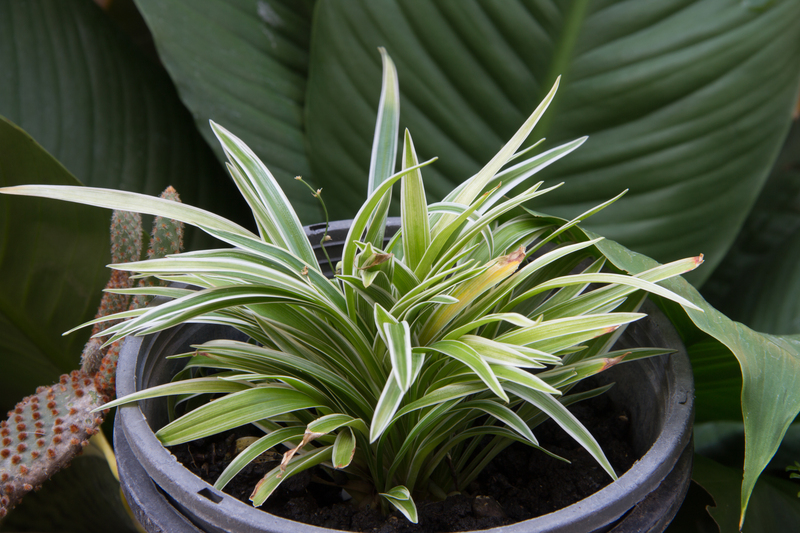Inspiring Young Minds: Building a Playful and Safe Garden
Posted on 20/09/2025
Inspiring Young Minds: Building a Playful and Safe Garden
Creating a garden that sparks curiosity, fosters learning, and prioritizes safety is a wonderful investment in any child's future. Whether you are a parent, teacher, or community organizer, designing a playful and safe garden offers an incredible opportunity to inspire young minds. In this comprehensive guide, you'll discover how to construct inviting, imaginative, and secure outdoor spaces where children can learn and grow.
The Importance of a Playful and Safe Garden for Children
A garden specifically tailored for young explorers is more than just outdoor space. It's a living classroom, a playground, and a safe haven all wrapped into one vibrant ecosystem. Encouraging children to engage with nature provides countless benefits:
- Physical Development: Running, climbing, and digging build motor skills and promote a healthy lifestyle.
- Cognitive Growth: Observing plants, insects, and natural processes ignites curiosity and enhances problem-solving abilities.
- Emotional Wellbeing: Time in a tranquil, engaging garden helps children relax and boosts self-esteem.
- Social Skills: Outdoor activities encourage teamwork, communication, and sharing responsibilities.

Key Principles to Build a Child-Friendly Garden
If you want to create a garden that inspires and protects young minds, planning is crucial. A well-designed playful and safe garden encompasses a wide array of features to delight children while ensuring their wellbeing.
1. Prioritize Garden Safety for Kids
Safety is the foundation. Before adding fun features, assess your garden for potential hazards. Consider these measures:
- Fencing and Boundaries: Install secure fencing to prevent little ones from wandering off. Gates with child-proof locks are essential.
- Non-Toxic Plants: Carefully select shrubs, flowers, and trees that pose no danger if touched or nibbled.
- Soft Surfaces: Use bark chips, rubber mats, or grass in play areas to cushion falls and prevent injuries.
- Tool and Chemical Storage: Lock away sharp gardening tools and chemicals in sheds out of children's reach.
- Safe Water Features: If you include a pond or fountain, ensure it's shallow, fenced, or securely covered.
2. Design for Creative Play and Exploration
A playful garden should have dedicated areas that invite creativity, discovery, and movement:
- Natural Play Structures: Incorporate logs, boulders, sand pits, and climbing frames made from safe materials.
- Hidden Paths: Winding trails with stepping stones, tunnels, or mini bridges spark a sense of adventure.
- Imaginative Zones: Set up a fairy house corner, dinosaur dig-site, or musical wall to feed imagination.
- Loose Parts (sticks, pebbles, leaves) for open-ended, creative construction and storytelling.
3. Encourage Learning Through Gardening
Transform your playful and safe garden into an accessible learning hub. Here's how to nurture young horticulturists:
- Children's Vegetable Plot: Dedicate a section for kids to plant fast-growing, easy-care vegetables like radishes or lettuce.
- Butterfly and Bee Gardens: Add nectar-rich flowers to attract pollinators, offering firsthand lessons in ecosystems.
- Composting Area: Teach waste reduction and soil health by composting fruit scraps and leaves.
- Sensory Beds: Install beds with various textures, scents, and tastes--think lavender, mint, and sunflowers.
Planning the Layout: Steps to a Playful and Safe Garden
Thoughtful planning ensures your garden suits both play and protection. Here's a step-by-step approach to inspire your landscaping project:
1. Survey Your Space
Walk the area with safety glasses. Identify sunny spots, shade, water access, and existing hazards. Make notes and sketches--visualizing how children might explore each area will help structure your plan.
2. Involve Young Minds in Design
Collaborate with your kids! Ask about their favorite games, colors, and animals. Let them help select plants and draw their dream play zones. Involving children kindles ownership and excitement for the garden.
3. Map Out Zones
- Active Play: Designate space for running, climbing, and swinging.
- Quiet Corners: Create shady nooks with benches or hammocks for rest and reading.
- Nature Nooks: Plan mini gardens for butterflies, birds, or small wildlife observation.
- Edible Gardens: Site raised beds where kids can easily access and care for their crops.
4. Choose Child-Safe Materials
Opt for smooth, durable, and weatherproof materials. Avoid sharp edges, toxic finishes, and splinters. Use untreated wood, recycled rubber, and non-slip surfaces where possible.
Essential Elements of a Safe and Inspiring Kids' Garden
To help you craft the ultimate garden for inspiring young minds, let's explore the must-have features proven to delight and safeguard children.
Secure Fencing and Gates
- Height and Strength: Ensure fences are tall enough to discourage climbing and robust enough for outdoor conditions.
- Visual Appeal: Paint with bright, welcoming colors or let kids decorate panels with their artwork.
- Visibility: Transparent or widely-spaced fencing lets parents keep a watchful eye on children.
Safe and Inviting Pathways
- Soft Surfaces: Use bark mulch, pea gravel, or synthetic turf to soften trips and falls.
- Accessible Routes: Wide, even paths ensure strollers and wheelchairs can navigate the garden.
- Lead to Surprises: Curve paths to secret spots or hidden features for that extra element of playfulness.
Inviting Play Equipment
- Swings and Slides: Install age-appropriate, safety-rated equipment over shock-absorbing bases.
- Naturally Inspired Structures: Climbing nets, tree stumps, and rope bridges add excitement while blending into the landscape.
- Cubby Houses and Teepees: Make cozy shelters for imaginative play and quiet time.
Water-Safe Splash Areas
- Mist Features: Set up misting stations or gentle sprinklers for cooling and sensory fun.
- Shallow Streams: Design artificial creeks no deeper than a few inches with gentle slopes.
- Water Tables and Basins: Offer supervised splash play without risk.
- Ponds with Safety Grates: Cover any water feature to prevent unsupervised access.
Edible Learning Gardens
- Raised Beds: Sturdy, easily reachable beds encourage hands-on planting and harvesting.
- Labeled Plants: Use bold, colorful labels and educational signs to identify veggies, herbs, and fruits.
- Pumpkin Patches or Sunflower Houses: Let kids grow giant plants for added wonder.
Sensory and Wildlife Habitats
- Texture Gardens: Feature lamb's ear, ornamental grasses, and smooth stones for touch exploration.
- Sound Features: Hang wind chimes, set up pebble paths, or build bamboo musical walls for auditory delight.
- Pollinator Attractors: Mix nectar florals like lavender, echinacea, and nasturtium for bees and butterflies.
- Bug Hotels and Birdhouses: Spark observation skills and caring for creatures big and small.
Safety First: Kid-Friendly Garden Maintenance
A garden's safety is always evolving. Implement these maintenance routines to sustain a secure haven for young visitors:
- Regular Inspections: Check for loose equipment, splinters, and overgrown pathways each week.
- Remove Hazards: Promptly clear fallen branches, exposed nails, and any fungi.
- Seasonal Plant Review: Ensure no toxic plants migrate into play zones.
- Sanitize Play Surfaces: Wash down equipment and paths to reduce germs and allergens.
- Update Safety Features: Replace damaged mats, locks, and signage promptly.
Gardening Activities to Inspire Young Minds
Turn your safe play garden into an interactive learning center with fun, educational projects. Here are some great ideas:
1. Sensory Scavenger Hunt
- Challenge kids to find objects by texture, smell, or sound--velvety leaves, spicy herbs, or chirping birds.
2. Garden Art Workshops
- Provide paints, pebbles, and flowers for natural art projects--make stepping stone mosaics or nature collages.
3. Mini Grower's Challenge
- Host contests for tallest sunflower, juiciest tomato, or most colorful bouquet grown from their patch.
4. Wildlife Observation Journals
- Encourage children to document insects, birds, and animal tracks with drawings and notes.
5. Composting and Worm Farming
- Show how kitchen scraps turn into rich soil. Set up a worm farm and track its progress over weeks.
Inclusivity: Making the Garden Accessible for All
A truly playful and safe outdoor space welcomes children of every ability. Consider these improvements for accessibility:
- Wheelchair-Friendly Paths: Smooth, wide, non-slip surfaces with gentle gradients.
- Raised Sensory Beds: Install at varying heights for standing and seated gardening.
- Big, Bright Signs: Use pictures and symbols alongside words for directions and plant IDs.
- Quiet Spaces: Provide calming retreats for children who become overwhelmed or need a sensory break.

Fostering Responsibility and Ownership in Children
Children thrive when they take pride in their environments. Assign simple gardening jobs--watering, weeding, feeding the worms--and rotate these among all helpers. Celebrate milestones like first sprouts, flowering, or harvests. This nurtures a sense of achievement and care for nature that lasts a lifetime.
Conclusion: Growing Hearts and Minds in Your Playful Garden
A playful and safe children's garden is an ever-changing landscape of excitement and discovery. By emphasizing safety, creativity, and inclusivity, you're not just building a fun backyard--you're cultivating future scientists, artists, and nature lovers.
Let your garden be the stage where young minds blossom and lifelong passions for the outdoors are formed. With thoughtful design, engaging activities, and mindful stewardship, your outdoor sanctuary will inspire, teach, and protect every child who steps inside.
It's time to pick up your shovel, spark imaginations, and begin growing the next generation of nature enthusiasts!

